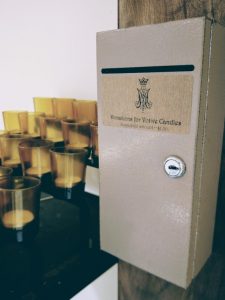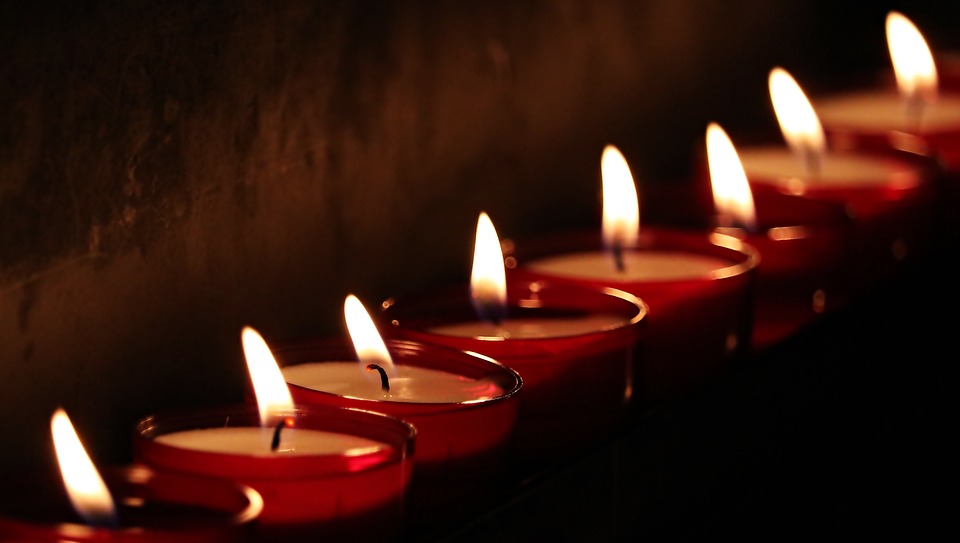Why We Light Candles
Go into just about any Catholic church anywhere in the world and you will see a rack of votive candles, usually in front of a statue, icon, or other sacred image. Our chapel of the Annunciation here at the Catholic Student Center is no exception. People can come in, say a prayer and light a candle. But have you ever thought about why we do this? What is the purpose of the candle? Why not just offer our prayer and be on our way?
Candles and prayer go hand in hand in the Catholic tradition. We are supposed to have at least two candles on the altar whenever Mass is said, but we may have up to six — and if the bishop is celebrating Mass, seven candles can be used! Candles are lit during times of Adoration. Many churches and chapels also use candles elsewhere in the sanctuary, such as near the tabernacle or by the ambo where the gospel is read. Even when no liturgy is taking place there is always at least one candle burning by the tabernacle indicating the Sacramental Presence of Christ.
In case all that were not enough to convince you that candles are a Big Deal in the Catholic Church, we also have the Paschal (Easter) candle, which is so special that it gets sung to each year. The great Easter proclamation called the Exultet is chanted by the deacon or other cantor during the Easter Vigil. In what is arguably the most glorious chant of the liturgical year, we find this passage about the candle:
On this, your night of grace, O holy Father,
accept this candle, a solemn offering,
the work of bees and of your servants’ hands,
an evening sacrifice of praise,
this gift from your most holy Church.But now we know the praises of this pillar,
which glowing fire ignites for God’s honor,
a fire into many flames divided,
yet never dimmed by sharing of its light,
for it is fed by melting wax,
drawn out by mother bees
to build a torch so precious.O truly blessed night,
when things of heaven are wed to those of earth,
and divine to the human.Therefore, O Lord,
we pray you that this candle,
hallowed to the honor of your name,
may persevere undimmed,
to overcome the darkness of this night.Receive it as a pleasing fragrance,
and let it mingle with the lights of heaven.
(You can see a wonderful video of the Exultet being chanted in Latin on Youtube).
What the Church sings about this most glorious candle at Easter tells us why we offer smaller votive candles throughout the year when we make special prayers and petitions. The candle is meant to be, in the words of the Exultet, a “solemn offering” and a “sacrifice of praise,” which God might “receive… as a pleasing fragrance.”
In what way is a candle a sacrifice? The Exultet tells us something about this, too. As the candle burns, it consumes itself. It is fueled by “melting wax, drawn out by mother bees, to build a torch so precious.” Of course the candle is not only the labor of bees. It is the labor of human hands — often multiple human hands that all went into keeping the bees, harvesting the wax, and forming the wax into a candle. When we burn the candle, this work of our labor is consumed. When we burn the candle in prayer, we are offering the fruit of our labor as a sacrifice to God, giving Him the time, energy, skill and material that went into making that candle. As long as the candle stays lit, the sacrifice is ongoing, thus extending in time our prayer. And that’s a pretty cool tradition.
But what if we didn’t make the candle ourselves? Most of us are not beekeepers or candle makers. So how does this idea of offering up the fruit of our labor work for us? This is precisely why most churches have donation boxes next to their votive candle racks. By making a donation to “purchase” a votive candle, you are making a sacrifice of the fruit of your labor in the form of money. Even if the money was a gift, you are still making a sacrifice of whatever goods you might have otherwise purchased with that money. And if you donate to the church more money than the votive candle is actually worth (which is usually not very much) you have the added spiritual graces gained by offering alms to help the church in the various other ministries it performs.
 This is why over fall break we installed a donation box by the votive rack in our campus chapel, and why I am writing this post. I don’t want people to think we’ve started to “sell” candles or are charging money for the privilege of saying a prayer. (The selling of spiritual goods is called “simony” and is considered to be a grave sin). We are not seeking donations as a fundraiser. Rather, we want to extend to students the opportunity to make their prayer more efficacious by adding to it whatever monetary sacrifice they might be able to offer. It’s not about the specific amount (our sign suggests one dollar, but this is merely a suggestion). Remember the tale in Luke 21 about the widow who puts two mites into the treasury, which Jesus says was worth more than any of the rich men’s offerings because she gave of her poverty whereas they gave from their excess. Students are free to light a candle for a dollar donation, a quarter, or nothing at all. Any monies collected will go primarily toward purchasing more votive candles, with any excess going toward other ministry expenses.
This is why over fall break we installed a donation box by the votive rack in our campus chapel, and why I am writing this post. I don’t want people to think we’ve started to “sell” candles or are charging money for the privilege of saying a prayer. (The selling of spiritual goods is called “simony” and is considered to be a grave sin). We are not seeking donations as a fundraiser. Rather, we want to extend to students the opportunity to make their prayer more efficacious by adding to it whatever monetary sacrifice they might be able to offer. It’s not about the specific amount (our sign suggests one dollar, but this is merely a suggestion). Remember the tale in Luke 21 about the widow who puts two mites into the treasury, which Jesus says was worth more than any of the rich men’s offerings because she gave of her poverty whereas they gave from their excess. Students are free to light a candle for a dollar donation, a quarter, or nothing at all. Any monies collected will go primarily toward purchasing more votive candles, with any excess going toward other ministry expenses.
Oh, and if you’ve ever wondered why we call these “votive” candles, the word comes from the Latin word votum, which originally meant “expressing a desire.” So the next time you are in the chapel, feel free to light a votive candle as a sacrificial offering, making your desires and petitions known to God.

